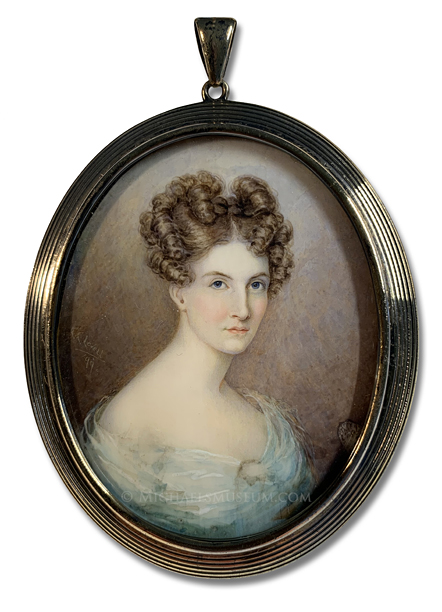| |
American Artist: Caroline Couper Stiles Lovell


Late Nineteenth Century Lady
of the American South
American
dated 1899
by Caroline Couper Stiles Lovell (1862-1947)
(signed obverse left, "C. C. Lovell / '99")
2 3/8 x 3 inches (sight)
watercolor on ivory; housed under glass in a
pendant-style gilded sterling silver case
About the Artist: Descended from a family of plantation owners with deep roots in the South, Caroline Couper Stiles was born in Georgia during the Civil War. She was on one hand a product of dignified antebellum society, and on the other hand a product of the spurned and economically depressed South of the postwar Reconstruction era. Most interestingly, she was also a collateral descendant of the esteemed early American miniaturist Edward Greene Malbone (1777-1807). The two were first cousins three times removed, Caroline's paternal great-grandmother having been a sister of Malbone's father. Generations after his death, Malbone maintained a larger than life influence on the Stiles and Mackay families -- their family estate was, in fact, called Malbone -- and this surely had some influence on the young Caroline's eventual vocation. She received her first formal training in art at Madame Lefebvre’s School, a French finishing school in Baltimore, where she was a boarding student for two years, from the age 16. It was not until after her marriage in 1884 to William Starrow Lovell, Jr., however, that she devoted herself seriously to a career in art. In 1888, the young couple settled in Birmingham, Alabama, where William pursued various business ventures that consumed most of his time and attention. Her husband otherwise preoccupied, Caroline frequently traveled to Manhattan, where she studied at the Art Students League of New York. (Later, she herself would be influential in establishing an Art League in Birmingham.) In 1896, she spent several months in Paris, where she is said to have studied the works of virtually every master at the Louvre. During this period, her skill as a miniature painter continued to excel earning her commissions from many of Birmingham's social elites and recognition throughout the South. Skill and popularity aside, however, Lovell remained active as a miniaturist for just a few short years (she was most active from about 1894 to 1899) before failing vision forced her to prematurely retire her paint and brushes. Thereafter, unable to paint, Lovell turned her energies to play writing. She is most remembered for Prince Charming's Fate (1903), an operetta in three acts, Wuthering Heights (1914), a play in five acts, adapted from a book of the same name by Emily Bronte, Swayam-Vara (1916), a one act comedy, The Dust of Death (1929), a play in 3 acts, and Mirage (1929), a play in three acts. In 1932, she earned accolades for her best-selling historical novel, The Golden Isles of Georgia, and in 1933 she penned a memoir of her youth titled, The Light of Other Days (which, though written in 1933, was not published until 1995, 48 years after her death). Surviving paintings by Lovell are rare. Some are known to to be in a collection of the Birmingham Museum of Art (Birmingham, Alabama).
|
|